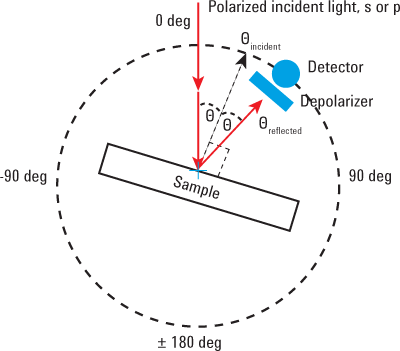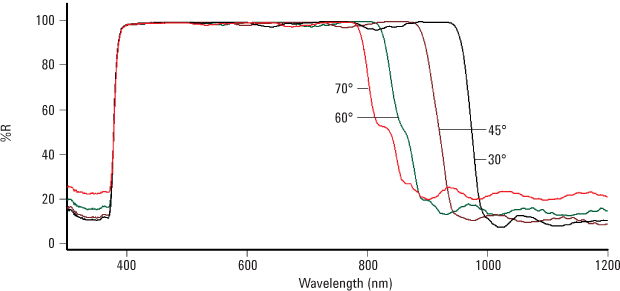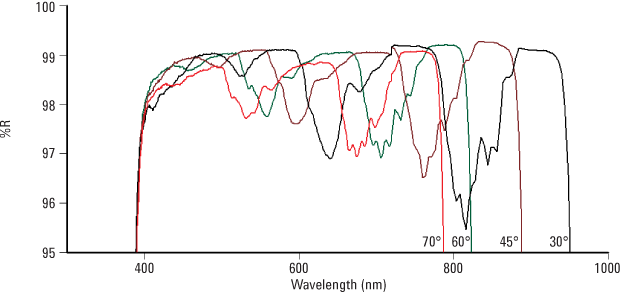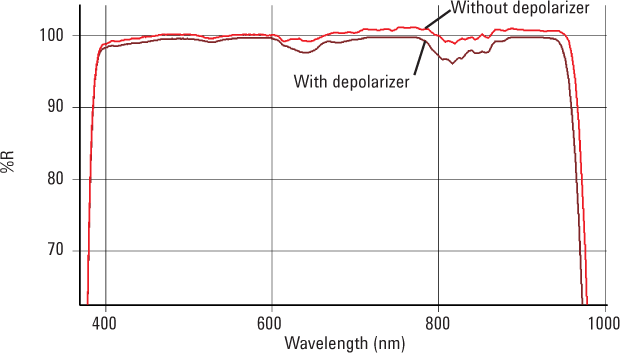Access Agilent eNewsletter, August 2013
>> Update My Profile | Subscribe to Access Agilent | Article Directory

Performance of compact visual displays: measure angular reflectance of optically active materials with the Agilent Cary 7000 UMS
By Travis Burt
Agilent Product Manager Cary UV-Vis-NIR
Huang ChuanXu
Agilent Molecular Product Specialist
and Andy Jiang
Agilent Molecular Product Specialist
The prevalence of visual displays in everyday use continues to grow as the size, weight, and power consumption are reduced and device mobility is subsequently improved. Optical displays based on light emitting diode (LED) and liquid crystal display (LCD) technologies find broad industrial and domestic use. As these technologies evolve, new materials must be characterized. The Agilent Cary 7000 Universal Measurement Spectrophotometer (UMS) is a ground-breaking instrument that successfully measures the optical properties of new materials used in optical displays.
Displays use backlighting to illuminate the full display area and liquid crystals to control the timing and color of the emissions presented to the viewer. The solid light guides used in backlighting are often made of an optically transparent polymeric material that is mass-produced. Reflectors enhance the optical and electrical efficiencies of solid light guides.
Backlight reflectors used in light guides must have a high reflectivity for efficient transport of light. Reflection values of greater than 98% are typical targets as multiple (tens of) reflections through the light guide would otherwise quickly extinguish available light. Multilayer optical coatings generate the high reflectivities of the thin reflector films, which can produce surfaces with optical activity. Accurate optical characterization (QA/QC) of the reflector prior to assembly requires careful consideration of optical activity to ensure that the detector records correct reflectance (%R) and transmission (%T) values.
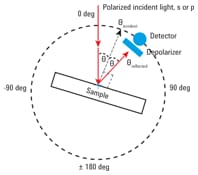 Enlarge
Enlarge
Figure 1. Schematic of the Cary 7000 UMS, which measures absolute specular reflection and transmission. You can mount a depolarizer just before the detector.
Measure both transmission and reflectance
We recently used an Agilent Cary 7000 UMS – a highly automated UV-Vis-NIR spectrophotometer – to measure an optically active reflector sample. The UMS performs variable angle transmission and absolute reflectance measurements. You can use the linearly polarized beam that is incident on the sample to measure transmission, and by rotating the detector assembly about an axis through the sample and perpendicular to the plane of incidence, to measure reflection. (See Figure 1.) Light incident onto the sample can be s or p polarized.
Our sample was approximately 50 mm square and 100 µm thick. To demonstrate optical activity of the sample before measurement in the Cary 7000 UMS, we illuminated the sample with s-polarized visible white light at angle and viewed the specularly reflected beam from the sample by eye through a second polarizer. We observed maximum intensity of the reflected beam by rotating the viewing polarizer a few degrees from the S (0-degree) position.
The angular offset between the incident s-polarized light and the visually detected light confirmed optical rotation of the reflected light hence and optically active material. This practical test demonstrated that we would need to insert a depolarizer before the detector during the spectrophotometric measurements.
 Enlarge
Enlarge
Figure 2. Reflection of backlight material at 70° (red), 60° (green), 45° (brown), and 30° (black) s-polarized light.
 Enlarge
Enlarge
Figure 3. Magnified view of Figure 2.
Process samples much more quickly
The detector module allowed us to place a depolarizer after the sample but before the detector, to correct for the optical rotation imposed on the reflected light by the sample. The depolarizer before the detector and the polarizer before the sample were included in the single baseline measurement taken before each sample measurement. The Cary 7000 UMS requires you to collect only a single baseline for all %R measurements at any angle for a given polarization. This unique feature dramatically improves the speed of analysis and sample throughput.
We collected reflectance data at four angles of incidence (AOI) – 70, 60, 45, and 30 degrees – over the spectral range 300-1200 nm (Figure 2). As shown more clearly in Figure 3, the sample demonstrated its design intent by displaying reflectance greater than 98%R over much of the visible wavelength range (400-800 nm).
The multiangle measurements showed consistent performance over a broad angular range in the region of interest (400-800 nm) and angular dependence outside this range (greater than 800 nm). AOI greater than 60 degrees also showed some diminishing of the %R quality in the 600-700 nm and 800-900 nm regions. The spectral dependence of the %R profile at these angles demonstrated that you may expect some color alterations for high angles of incidence.
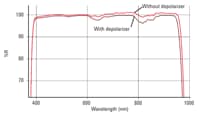 Enlarge
Enlarge
Figure 4. Absolute reflectance with and without a depolarizer. Without the depolarizer, %R values artificially exceed 100%.
Depolarizer enables correct results
Figure 4 demonstrates the importance of depolarizing the light after the sample, but just before the detector. Without the depolarizer, the optical activity of the sample causes the %R values to artificially exceed 100%. The depolarizer corrects for the optical rotation of the light and gives the correct values.
The Agilent Cary 7000 UMS is a valuable tool to measure the optical properties of next-generation materials used in optical displays. You can accurately measure the optical rotation imposed by a specialized polymeric coating on the sample, because the instrument uses linearly polarized incident light and depolarizes the reflected light before it is detected and processed.
If you need high-quality spectrophotometric results for advanced materials applications, consider the Agilent Cary 7000 Universal Measurement Spectrophotometer. Read the full Application Note (5991-2508EN) about measurement of optically active materials. Then watch this video to see the new Cary 7000 UMS in action.
>> Update My Profile | Subscribe to Access Agilent | Article Directory
